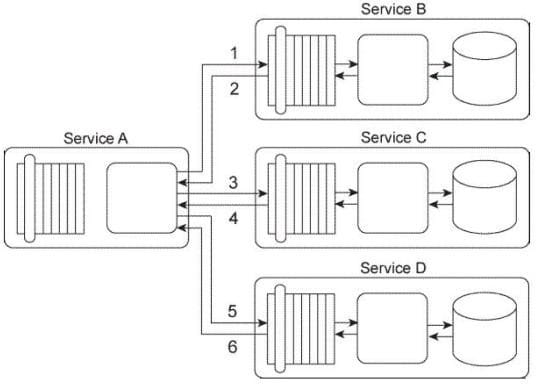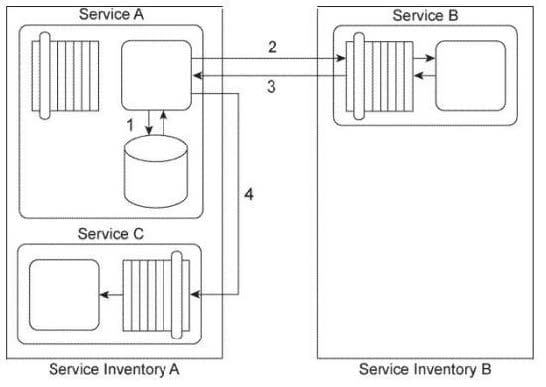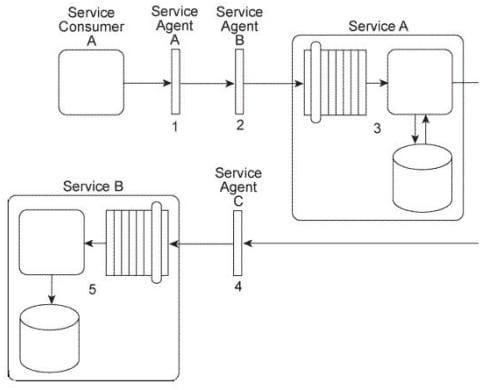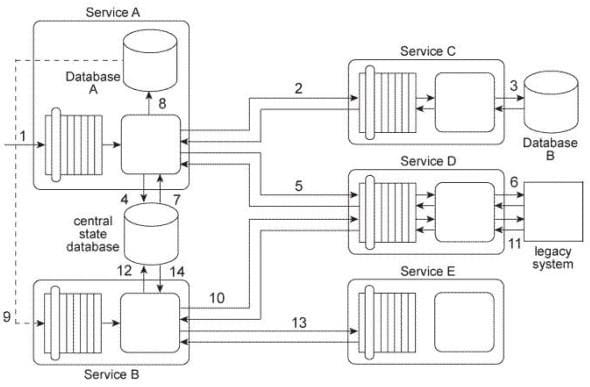
S90.09 Exam Questions & Answers
Exam Code: S90.09
Exam Name: SOA Design & Architecture Lab
Updated: Apr 26, 2024
Q&As: 40
At Passcerty.com, we pride ourselves on the comprehensive nature of our S90.09 exam dumps, designed meticulously to encompass all key topics and nuances you might encounter during the real examination. Regular updates are a cornerstone of our service, ensuring that our dedicated users always have their hands on the most recent and relevant Q&A dumps. Behind every meticulously curated question and answer lies the hard work of our seasoned team of experts, who bring years of experience and knowledge into crafting these premium materials. And while we are invested in offering top-notch content, we also believe in empowering our community. As a token of our commitment to your success, we're delighted to offer a substantial portion of our resources for free practice. We invite you to make the most of the following content, and wish you every success in your endeavors.

Download Free SOA S90.09 Demo
Experience Passcerty.com exam material in PDF version.
Simply submit your e-mail address below to get started with our PDF real exam demo of your SOA S90.09 exam.
![]() Instant download
Instant download
![]() Latest update demo according to real exam
Latest update demo according to real exam
* Our demo shows only a few questions from your selected exam for evaluating purposes
Free SOA S90.09 Dumps
Practice These Free Questions and Answers to Pass the Certified SOA Architect Exam
Service A is a task service that is required to carry out a series of updates to a set of databases in order to complete a task. To perform the database updates Service A must interact with three other services, each of which provides standardized data access capabilities.
Service A sends its first update request message to Service B (1), which then responds with a message containing a success or failure code (2). Service A then sends its second update request message to Service C (3), which also responds with a message containing a success or failure code (4). Finally, Service A sends a request message to Service D (5), which responds with its own message containing a success or failure code (6).

You've been asked to change this service composition architecture in order to fulfill a set of new requirements: First, if the database update performed by Service B fails, then it must be logged by Service
A. Secondly, if the database update performed by Service C fails, then a notification e-mail must be sent out to a human administrator. Third, if the database update performed by either Service C or Service D fails, then both of these updates must be reversed so that the respective databases are restored back to their original states. What steps can be taken to fulfill these requirements?
A. Service A is updated to perform a logging routine when Service A receives a response message from Service B containing a failure code. Service A is further updated to send an e-mail notification to a human administrator if Service A receives a response message from Service C containing a failure code. The Atomic Service Transaction pattern is applied so that Services A, C, and D are encompassed in the scope of a transaction that will guarantee that if the database updates performed by either Service C or Service D fails, then both updates will be rolled back.
B. The Compensating Service Transaction pattern is applied to Service B so that it invokes exception handling logic that logs failed database updates before responding with a failure code back to Service
A . Similarly, the Compensating Service Transaction pattern is applied to Service C so that it issues an e-mail notification to a human administrator when a database update fails. The Atomic Service Transaction pattern is applied so that Services A, C, and D are encompassed in the scope of a transaction that will guarantee that if the database updates performed by either Service C or Service D fails, then both updates will be rolled back. The Service Autonomy principle is further applied to Service A to ensure that it remains consistently available to carry out this sequence of actions.
C. The Atomic Service Transaction pattern is applied so that Services A, C, and D are encompassed in the scope of a transaction that will guarantee that if the database updates performed by either Service C or Service D fails, then both updates will be rolled back. The Compensating Service Transaction pattern is then applied to all services so that the scope of the compensating transaction includes the scope of the atomic transaction. The compensating exception logic that is added to Service D automatically invokes Service B to log the failure condition and Service C to issue the e-mail notification to the human administrator. This way, it is guaranteed that the compensating logic is always executed together with the atomic transaction logic.
D. None of the above.
Service A is a task service that sends Service B a message (2) requesting that Service B return data back to Service A in a response message (3). Depending on the response received. Service A may be required to send a message to Service C (4) for which it requires no response. Before it contacts Service B, Service A must first retrieve a list of code values from its own database (1) and then place this data into its own memory. If it turns out that it must send a message to Service C, then Service A must combine the data it receives from Service B with the data from the code value list in order to create the message it sends to Service C. If Service A is not required to invoke Service C, it can complete its task by discarding the code values.
Service A and Service C reside in Service Inventory A. Service B resides in Service Inventory B.

You are told that the services in Service Inventory A are all SOAP-based Web services designed to exchange SOAP 1.1 messages and the services in Service Inventory B are SOAP-based Web services designed to exchange SOAP 1.2 messages. Therefore, Service A and Service B cannot currently communicate. Furthermore, you are told that Service B needs to access a shared database in order to retrieve the data required by Service A. The response time of the database can sometimes be lengthy, which would cause Service A to consume too much resources while it is waiting and keeping the code values in memory. How can this service composition architecture be changed to avoid these problems?
A. The Protocol Bridging pattern can be applied by establishing an intermediate processing layer between Service A and Service B that can convert SOAP 1.1 messages to SOAP 1.2 messages and vice versa. The Service Data Replication pattern can be applied to Service B so that it is given a dedicated database with its own copy of the data it needs to access. The Service Normalization pattern can then be applied to ensure that the data within the replicated database is normalized with the shared database it is receiving replicated data from.
B. The Protocol Bridging pattern can be applied by establishing an intermediate processing layer between Service A and Service B that can convert SOAP 1.1 messages to SOAP 1.2 messages and vice versa. The Service Statelessness principle can be applied with the help of the State Repository pattern so that Service A can write the code value data to a state database while it is waiting for Service B to respond.
C. The Protocol Bridging pattern can be applied by establishing an intermediate processing layer between Service A and Service B that can convert SOAP 1.1 messages to SOAP 1.2 messages and vice versa. The Intermediate Routing pattern can be applied to dynamically determine whether Service A should send a message to Service C. The Service Autonomy principle can be applied to Service A to further increase its behavioral predictability by reducing the amount of memory it is required to consume.
D. None of the above.
Service A is a task service that sends Service B a message (2) requesting that Service B return data back
to Service A in a response message (3). Depending on the response received. Service A may be required
to send a message to Service C (4) for which it requires no response.
Before it contacts Service B, Service A must first retrieve a list of code values from its own database (1)
and then place this data into its own memory. If it turns out that it must send a message to Service C, then
Service A must combine the data it receives from Service B with the data from the code value list in order
to create the message it sends to Service C. If Service A is not required to invoke Service C, it can
complete its task by discarding the code values.
Service A and Service C reside in Service Inventory A. Service B resides in Service Inventory B.

You are told that the services in Service Inventory A were designed with service contracts based on different design standards than the services in Service Inventory B. As a result, Service A and Service B use different data models to represent the data they need to exchange. Therefore, Service A and Service B cannot currently communicate. Furthermore, Service C is an agnostic service that is heavily accessed by many concurrent service consumers. Service C frequently reaches its usage thresholds during which it is not available and messages sent to it are not received. How can this service composition architecture be changed to avoid these problems?
A. The Data Model Transformation pattern can be applied by establishing an intermediate processing layer between Service A and Service B that can transform a message from one data model to another at runtime. The Intermediate Routing and Service Agent patterns can be applied so that when Service B sends a response message, a service agent can intercept the message and, based on its contents, either forward the message to Service A or route the message to Service C . The Service Autonomy principle can be further applied to Service C together with the Redundant Implementation pattern to help establish a more reliable and scalable service architecture.
B. The Data Model Transformation pattern can be applied by establishing an intermediate processing layer between Service A and Service B that can transform a message from one data model to another at runtime. The Asynchronous Queuing pattern can be applied to establish an intermediate queue between Service A and Service C so that when Service A needs to send a message to Service C, the queue will store the message and retransmit it to Service C until it is successfully delivered. The Service Autonomy principle can be further applied to Service C together with the Redundant Implementation pattern to help establish a more reliable and scalable service architecture.
C. The Data Model Transformation pattern can be applied by establishing an intermediate processing layer between Service A and Service B that can transform a message from one data model to another at runtime. The Intermediate Routing and Service Agent patterns can be applied so that when Service B sends a response message, a service agent can intercept the message and, based on its contents, either forward the message to Service A or route the message to Service C . The Service Statelessness principle can be applied with the help of the State Repository pattern so that Service A can write the code value data to a state database while it is waiting for Service B to respond.
D. None of the above.
Service Consumer A sends a message to Service A. Before the message arrives with Service A, it is intercepted by Service Agent A (1). which checks the message for compliance to Policy A that is required by Service A. If the message fails compliance, Service Agent A will not allow it to proceed and will instead write the message contents to a log. If the message does comply to the policy, it continues to be transmitted toward Service A, but before it arrives it is intercepted by Service Agent B (2), which validates the security credentials in the message header. If the security credential validation fails, the message is rejected and a runtime exception is raised. If the security credentials are validated, the message is sent to Service A.
Upon receiving the message, Service A retrieves a data value from a database and populates the message header with this data value (3) prior to forwarding the message to Service B. Before the message arrives at Service B. it is intercepted by Service Agent C (4) which checks the message for compliance with two policies: Policy B and Policy C. Policy B is identical to Policy A that was checked by Service Agent
A. To check for compliance to Policy C. Service Agent C uses the data value added by Service A. If the message complies with both of the policies, it is forwarded to Service B (5), which stores the message contents in its own database.

You are told that Policy B and Policy C have changed. Also, in order to carry out the compliance check of Policy C, Service Agent C will now require a new data value from the Service B database. How can this service composition architecture be changed to fulfill these new requirements?
A. The Policy Centralization pattern can be applied so that only one service agent is used to enforce Policy A and Policy B. Service A is redesigned to first query Service B for the value required by Service Agent C to check the compliance of the updated Policy C. If the compliance check is successful, the message is sent to Service B .
B. The Policy Centralization pattern can be applied so that only one service agent is used to enforce Policy A and Policy B. Service Consumer A is redesigned to first query Service B for the value required by Service Agent C. This way, Service Consumer A can include this value in the message header prior to sending the message to Service A .
C. The Policy Centralization pattern can be applied so that only one service agent is used to enforce Policy A and Policy B. The policy enforcement logic for Policy C is removed from Service Agent C and instead embedded within the logic of Service B . This way, Service B can itself retrieve the value required to check compliance with Policy C. If the message received is not in compliance, Service B will reject it.
D. None of the above.
Service A is an orchestrated task service that is invoked by a separate composition initiator (1) and then sends a request message to Service C (2). Service C queries Database B to retrieve a large data record
(3) and provides this data in a response message that is sent back to Service A. Service A temporarily stores this data in a central state database (4) and then sends a request message to Service D (5), which accesses a legacy system API to retrieve a data value (6). Service D then sends this data value in a response message back to Service A. The data in the state database is subsequently retrieved by Service A (7) and merged with the newly received data value. This combined data is written to Database A (8), which triggers an event that results in the invocation of Service B (9).
Service B is an orchestrated task service that sends a request message to Service D (10). which accesses a legacy system API to retrieve a data value (11) and then sends this data value in a response message back to Service B. Service B temporarily stores this data in a central state database (12) and then sends a request message to Service E (13), which performs a runtime calculation and then responds with the calculated data value back to Service B. The data in the state database is then retrieved by Service B (14) and merged with the calculated data value. Service B then uses the merged data to complete its business task.
The following specific problems and requirements exist:

Upon reviewing these requirements it becomes evident to you that the Enterprise Service Bus compound
pattern will need to be applied. However, there are additional requirements that need to be fulfilled. To build this service composition architecture, which patterns that is not associated with the Enterprise Service Bus compound pattern need to also be applied? (Be sure to choose only those patterns that relate directly to the requirements described above. Patterns associated with the Enterprise Service Bus compound pattern include both the required or core patterns that are part of the basic compound pattern and the optional patterns that can extend the basic compound pattern.)
A. Atomic Service Transaction
B. Compensating Service Transaction
C. Data Format Transformation
D. Data Model Transformation
E. Event-Driven Messaging
F. Intermediate Routing
G. Policy Centralization
H. Process Centralization
I. Protocol Bridging
J. Redundant Implementation
K. Reliable Messaging
L. Service Data Replication
M. State Repository
Viewing Page 3 of 3 pages. Download PDF or Software version with 40 questions

